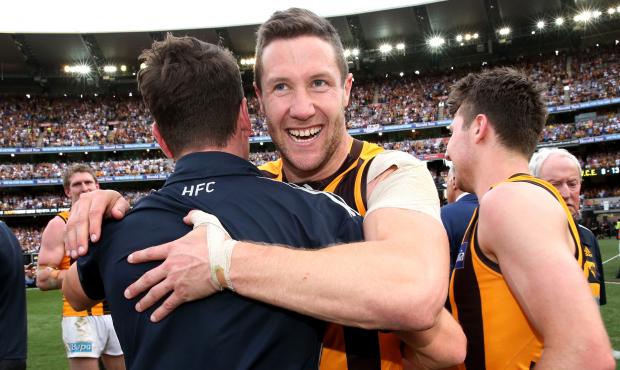• Draft order: Your club's provisional picks
• Who your club is targeting this off-season
• Click here for the NAB AFL Trade Hub
CLUBS will only receive a first-round compensation pick after losing a free agent in 2015 if the player's new contract ranks them among the top five per cent of AFL wage earners aged 25 and older.
The AFL last week gave club CEOs their first indication of the factors taken into account when determining free agency compensation.
It is believed the CEOs were told the 2015 threshold for a first-round compensation selection is significantly higher this year compared to 2014, when Melbourne received pick No.3 as compensation for losing defender James Frawley to Hawthorn.
It was revealed that the AFL adds all the base and additional services agreement (ASA) payments of players aged 25 or older, of whom there are about 270, to determine where the free agent's new contract sits.
AFL.com.au understands that if a free agent's new contract puts them in the top five per cent of that group at the time the free agency offer is lodged, then their former club is eligible to receive a first-round compensation pick.
To put that figure in perspective, a wage that ranks in the top five per cent of players aged 25-plus would put the free agent among the game's top 15 earners.
Despite the clubs' push to know what that might mean in dollar terms, the AFL explained it was impossible to attach a specific dollar figure to compensation because the numbers constantly changed.
That means the minimum threshold for a first-round compensation pick can change from year to year – or even week-to-week – depending on how many players aged 25 and above move into the higher earning wage category when the offer is lodged.
However, clubs left the meeting with the impression the minimum threshold had increased this year, compared to 2014, due to a surge in the number of AFL players aged 25 and above earning a high wage in 2015.
The AFL also explained that if a player's contract offer ranked in the next 10 per cent band then he would command compensation at the end of the first round, the next 15 per cent earned a second-round pick and the next 20 per cent earned a pick at the end of the second round.
It means that of all 2015's mooted free agency moves, only the new contract reportedly being offered to Adelaide's free agent Patrick Dangerfield is close to earning first-round compensation in this year's trade period, although even this remains uncertain.
In 2014, the AFL annual report showed that six per cent of AFL players (which includes those under 25 and therefore not part of the sample relevant to compensation) earned more than $600,000. However, the figure needed to earn a first-round pick would be different this year.
Melbourne received pick No.3 for newly minted premiership Hawk James Frawley. Picture: AFL Media
The information session came after clubs made repeated calls for transparency during the debate about the compensation Carlton could earn if Matthew Kreuzer left the Blues as a free agent.
One club told AFL.com.au they now understood better why the AFL could not give a clearer indication on compensation, because it was a moveable feast.
Under the formula, the Brisbane Lions could still be in line for a second-round pick (currently No.22) for Matthew Leuenberger, as his new contract might still rank him among the top 30 per cent of players aged 25 and over.
The compensation West Coast could earn if Scott Selwood leaves remains something of an unknown, although Eagles CEO Trevor Nisbett said he hoped for a first-round pick.
Neither the Brisbane Lions nor the Eagles have ruled out the prospect of matching any offer for their restricted free agents if they leave.
Under the rules, compensation is based on the new contract of the free agent and his age.
Draft picks are also allocated to clubs based on the net total points for free agents lost and gained during the transfer period and can be slotted in to one of five places: first round, end of first round, second round, end of second round and third round.
The committee can recommend alternative outcomes to the AFL's football operations manager Mark Evans if the formula produces a materially anomalous result.


